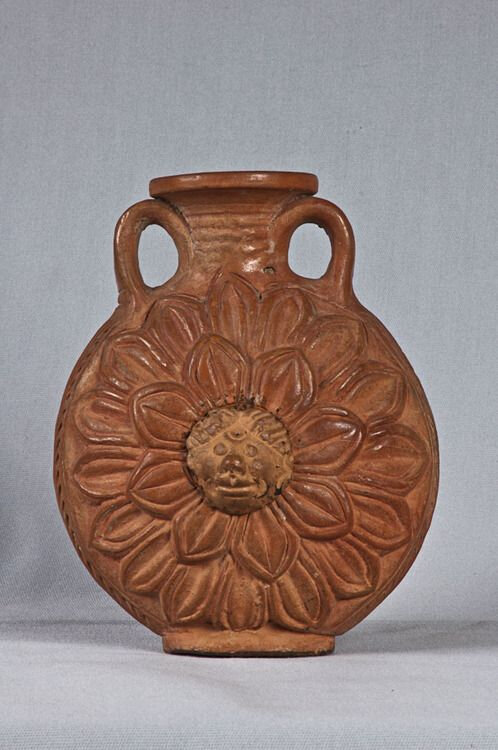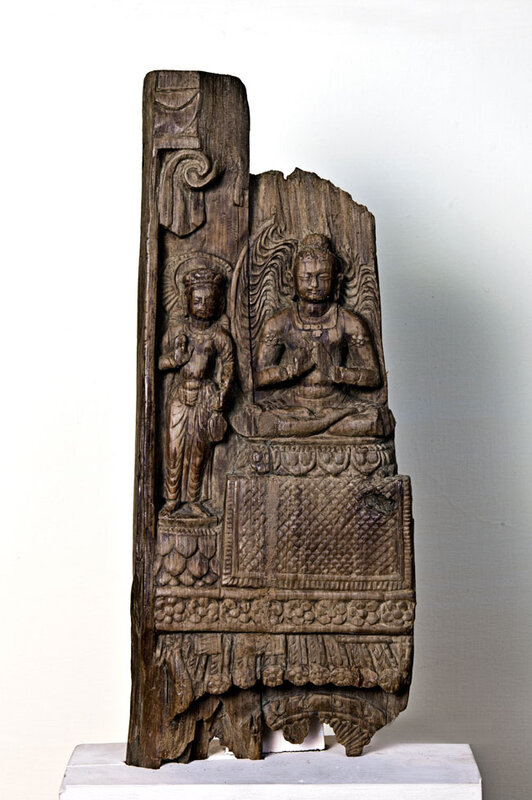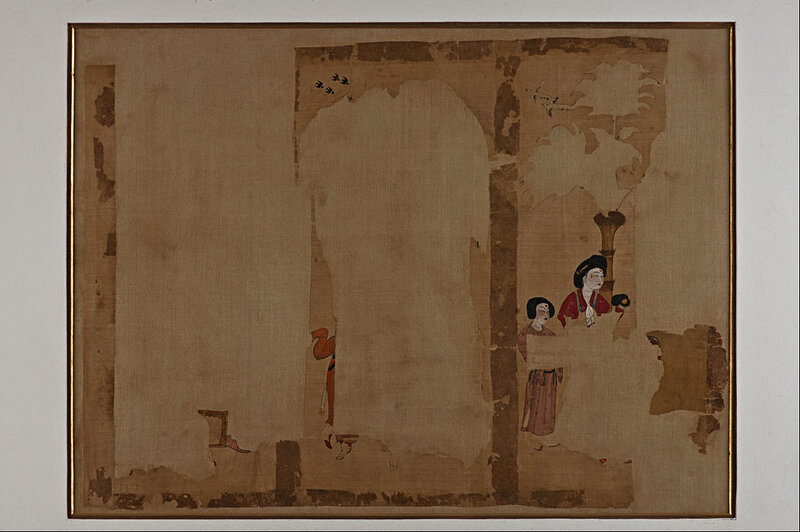Central Asian Antiquities at National Museum, New Delhi (India)
Tang dynasty trade routes.
The collection of Central Asian Antiquities with more than twelve thousand objects from Xinjiang region of Chinese Turkestan was discovered by Sir Aurel Stein during his three expeditions in 1900-1901, 1906-1908 and 1913-1916. This is one of the most prestigious and rare collections of Central Asian antiquities at the National Museum.
The objects displayed in the gallery were discovered mainly from the oasis along the ancient trade route popularly known as southern and northern Silk Roads. Frequent movements of people of different regions, faiths and cultures resulted in the emergence of a composite cultural tradition which is marked by the presence of Hellenistic, Sassanian, Uigurian, Chinese, Tibetan and Indian elements in the Central Asian Art.
The selected items on display, ranging roughly from the 3rd to 12th century C.E, are murals, silk paintings, ramie, paper, wood, terracottas, stuccos, wooden objects, Kharoshti documents and textiles.
A beautiful Chinese bronze image of the seated Buddha of Ming dynasty in the centre draws attention to visitors in the gallery. The walls of two galleries are occupied mostly by the paintings on silk, ramie and paper from Dunhuang, dated from the 7th to 10th century. These paintings are excellent in treatment of forms and colour scheme. The portrayal of Paradise of Amitabha and Avalokitesvara (Both deities of Vajrayana Buddhism) in different forms, and of Buddha and his life scenes are popular subjects. The rendering of Avalokitesvara with thousand arms and each palm having one eye is also remarkable. A sketch showing a procession of Bactrian camels and horses led by a man is a fine representation of caricature art. Three folios of the manuscript ‘Astasahasrika prajnaparamita hridyasutra’ illustrated with Lokpala figures are also among the significant exhibits.
The gallery also has three large sized painted silk pannels from 7 to 10 th century C.E. which belong to Astana. These panels, used for covering dead bodies, depict the legendary hero Fuxi and his consort Nuwa with entwined serpentine bodies.
The rich tradition of wall paintings of Central Asia have been represented by a few exquisite wall painting fragments. The one depicting Buddha and six monks from Miran, dated around 3rd- 4th century C.E. and bearing Sassanian, Hellenistic and Indian elements, is outstanding. Murals from Balawaste showing Indra and Vairochana and the cosmic Buddha dated between the 6th and 8th century CE also deserve special mention. The painted wooden panels from Ulug Mazar and Farhad-Beg-Yailaki, dated around 6th century CE, depicting Buddha are other outstanding creations. The terracotta art on display include human and animal figurines from the Khotan region, and stuccos from Astana. These stuccos, mostly painted in different colours and patterns, sometimes display peculiar facial expressions as well.
The strong Indian influence in Central Asia is marked by the presence of the Kharosthi script and the use of Prakrit and Sanskrit language. A few wedge shaped or rectangular wooden tablets, on display, belonging to the 3rd century C.E. from Niya and Loulan region provide valuable information about the contemporary society.
The Central Asian textiles introduced a vast variety and sophisticated technique of weaving, dying and printing. An embroidered fragment from Dunhuang showing the Thousand Buddhas present a unique example.
Amidst other miscellaneous works of art, beads, coins and leather objects, is a fragment of wood carving from Khotan dated to the 6th and 7th century C.E. showing a seated Buddha in Dharmachakra Mudra and accompanied by Avalokitesvara on his right.
Buddha with Six Disciples, 3rd-4th century A.D, Miran, Xinjiang, China. Wall painting, 57.2 x 100.2 cm, Acc. No. M. 111.003 (99/1/44). © National Museum, New Delhi.
Fragment of a wall painting from a stupa in Miran. The painting preserves only the bust of the Buddha, looking at the spectators, and gesturing his right hand in giving assurance (abhaya mudra). He wears a red sanghati(unstitched upper-garment) that covers both of his shoulders. On his left, six monks, probably his disciples, are seen. One of them is holding a chowrie. On the left of these monks, a tree is seen with blooming coloured flowers, and against it right arm of a figure is seen holding flowers in the hand. Probably, it is a scene from the conversion of six Sakya Princes. The painting shows strong Hellenistic elements, as strong features of naturalism and picturesque ness can be seen experienced into this wall painting. These elements were introduced into Art after the death of Alexander the great, and continued to vibrate the Art world. Since Alexander was from Hellenes the art was known as Hellenistic.
Head of a Bodhisattva, 3rd - 4th Century A.D., Miran, Xinjiang, China. Stucco. Height : 26 cm, Acc. No. M.xv.015 (99/7/26). © National Museum, New Delhi.
Well modelled life-size head of a Bodhisattva. The wavy hair of this figure fall symmetrically on either side of his forehead and face. The face expresses calm and contemplative mood by showing the half closed eyes (as in meditation). It also shows thick lips and long nose. Style of the hair and the facial features of the figure exhibit strong Hellenistic influence. It shows strong features of naturalism and picturesque ness which can be seen into this stucco object. These elements were introduced into Art after the death of Alexander the great, and continued to vibrate the Art world. Since, Alexander was from Hellenes the art was known as Hellenistic.
Pilgrim's bottle, 4th - 5th Century A.D., Yotkan, Xinjiang, China. Terracotta. Height: 16.3 cm. Acc. No. Yo.01 (2003/3/940). © National Museum, New Delhi.
Well-shaped bottle seems like a pilgrim's bottle. Either side of the body of the bottle is decorated with a fully blossomed lotus. The lotus is having two rows of petals. Central part of each lotus is decorated with an applique grotesque human face. The bottle has a small mouth. Through two ring-like handles, the bottle could be hung easily on the waist for carrying extremely pious water. The site of Yotkan and nearby Khotan has thrown numerous beautiful terracotta objects. This site is located in the Western Chinese Turkistan of China.
Head of a figure, 6th - 7th Century A.D., Khotan, Xinjiang, China. Terracotta. Height: 13 cm, Acc. No. Har. 06 (2003/7/1925). © National Museum, New Delhi.
Excellently modeled head of a figure, with a pair of large almond-shaped eyes, is shown in relief. Wavy locks of hair fall over the forehead. This head is a fine example of amalgamation of Indian and Hellenistic elements. It also shows thick lips and long nose. Style of the hair and the facial features of the figure exhibit strong Hellenistic influence. It shows strong features of naturalism and picturesque ness which can be seen into this stucco object. These elements were introduced into Art after the death of Alexander the great, and continued to vibrate the Art world. Since, Alexander was from Hellenes the art was known as Hellenistic. This object came from the personal collection of Mr. Harding who contributed many artefacts to Sir Aurel skin during his expeditions in Central Asia.
Seated Buddha with Avalokitesvara, 6th - 7th Century A.D., Khotan, Xinjiang, China. Wood. Height: 33 cm. Acc. No. Har. 029 (99/6/6). © National Museum, New Delhi.
This fragment of the wooden panel is showing the Buddha seated on the lotus throne in the posture of Vajrasana and hands in vyakhyana mudra. On his right, Avalokitesvara is standing on the lotus stand. His right hand is in abhaya mudra. He is holding with his left hand a amrtakalasa (vase). Left portion of the panel is missing. The figures show Gandharan element
Lady horse rider, 7th - 8th Century A.D., Astana, Xinjiang, China. Stucco, painted. Height : 24.5 cm. Acc. No. Ast.iii.2.016 and Ast.iii.2.022 (2003/7/1922). © National Museum, New Delhi.
This beautiful sculpture depicts a lady horse-rider of the T'ang period (618 - 906 A.D.). She wears a high cap, tight fitting tunic and pants. She is riding a horse with saddle black on tiger-skin saddle cloth with flowing straps on near side, white streak down face. Her forehead is decorated with a beauty mark in red. She sits astride, holding reins. She wears long trousers black shoes small dark blue bodice with V-shaped opening in front and short upper - sleeves. Head and face is very neatly modelled and finished. Hair is black her done in high topknot over which is painted mesh of hair - net in grey color.
From this particular site of Astana many horse-riders were found but this was the only example of a lady-horse-rider while others were in military gear of men. All these mounted figures were evidently meant to symbolize the retinue desired for the dead in his future abode. The lady and her horse are typically Chinese in style. Horses played very important role in the Chinese history. At one point of time Chinese were paying heavily for the strong West Asian horses, as the horses which were found in China were pygmy in size and being heavy sluggish in movement. Hun attackers used to take advantage of the situation and after attacking and looting the Chinese dominion used to swiftly go back. The people were so enthralled by the majestic horses that horse was treasured and appreciated by one and all. It also got important representations in the Chinese Art. It changed the dress style of Chinese soldiers as they laid aside their traditional dress in order to adopt the high boots, baggy trousers and close-fitting tunic evolved by the attacker&rsquos life-style and it brought Ferghana known for the best horses within reach of the Chinese.
Ladies in a garden, 7th - 8th Century A.D. © National Museum, New Delhi, Astana, Xinjiang People's Republic of China. Silk Painting, 37.5 x 54 cm, Acc. No. (a) Ast. iii. 4. 010 b-j (2003/17/354), (b) Ast. iii. 4. 010.a (2003/17/355). © National Museum, New Delhi.
Fragment of a charmingly painted panel of the well bedecked ladies with attendants in a garden. The faces of the ladies are decorated with beauty marks in red. Their coiffure is elaborately decorated with golden hair-pins. One of the attendants is seen with a musical instrument. It is a masterpiece of the T'ang style (618 - 906 A.D.) of secular paintings on silk.'The general scheme of the painting seems clear. It was a frieze-like composition, whether meant to be rolled or not, divided into compartments by strips of thin brown brocade pasted on to the silk, and framed at top and bottom by a narrow border of the same material.
One of the upright strips has been preserved entirely, so that the height of the picture is known to be about 21 in. we can also tell that the width of one compartment, and possibly was about 8 1/2 in. In each division was a group of figures standing under a tree. Some of these were ladies with attendant pages, others were dancers and musicians.
The painting shows T'ang ideal of full, rounded cheeks, small mouth with full, red lips, and rather massive figure. Portrayed with same T'ang conventions, such as the two or three lines indicating the curves of the throat and there is a remarkable similarity in the heavily heaped-up coiffure, with a big knot in front over the forehead. In pictures we notice the same fashion of painting spots of colour on forehead and cheek. In the secular painting of this period, there was a common ideal of style which pervaded China from east to west and imposed itself even outside the Empire, and in these fragments a genuine echo of the central school of Chinese painting is revealed as it was in the early eighth century.
Paradise of Bhaisajyaguru, 7th - 8th Century A.D., Dunhuang, Gansu, China. Silk Painting, 119 x 117.5 cm. Acc. No. Ch. liii. 002 (2003/17/348). © National Museum, New Delhi.
Bhaisajyaguru, the Medicine Buddha, is seen here seated in the vajrasanaposture on a colourful lotus. He is seated in the Paradise of the East and is escorted by two Bodhisattvas and two monks having haloes Belocw him is a scene showing a dancing girl, accompanied with a group of musicians. The side scenes on the right of the banner are missing and on the left side of banner Nine Forms of Violent and untimely Death has been shown. The Medicine Buddha saves his devotees from such despicable deaths, and seen here are :- (i) incomplete, (ii) man and woman besides a cauldron as a red-haired demon stretches out his hand towards them, (iii) drowning man, (iv) man on a high seat who is being taken away by a demon, (v) sick man to whom two monks read from the scrolls: one who cannot procure a doctor should get a monk to read the sutras, (vi) man kneeling on platform as a demon rushes towards him, (vii) man with falcon on wrist, (viii) man encircled by flames or violent death, (ix) destroyed.
Bhaisajyaguru is the Buddha of Healing, whose Paradise of Lapis Lazuli is in the east. His cult centres around life in this world to achieve health and longevity. All glory and wordly possessions seem empty when one lies gravely ill. Fervent prayers for the recovery of the sick had a poignancy of its own in ancient times when medical aid was in the formative.
Bhaisajyaguru had taken twelve great vows for the welfare of beings as well as vowed to prevent nine forms of violent and untimely death. The paradise of Bhaisajyaguru was made of vaidurya or lapis lazuli, free from blemishes. He has a dark blue colour like lapis lazuli. He is flanked on the right by Suryaprabha with his two acolytes and on the left by Candraprabha again accompanied by his two acolytes. Below them are Eight Bodhisattvas, four on the right and other four on the left. According to the three Chinese translations of Bhaisajyaguru-sutra by Srimitra (ch.12, A.D. 317-322), Dharmagupta (A.D. 616) and Hsuan-tsang (A.D. 650), if one recalls the name of Bhaisajyaguru at the moment of death, the Eight Bodhisattvas come down to take the devotee to his paradise.
Avalokitesvara, 865 A. D., Dunhuang, Gansu, China, Silk Painting, 74 x 59 cm, Acc. No. Ch.00451 (2003/17/352). © National Museum, New Delhi.
Fragment of a banner showing upper part of Avalokitesvara. He wears a rich ornamented crown with Dhyani Buddha as the crest jewel. His right hand holds a willow spray. On the left of Avalokitesvara a rectangular cartouche is shown bearing an inscription which has been written in Chinese characters. The inscription is translated by Waley as below: -
'Praise to the Great Merciful Great Compassionate Saviour from Pain Avalokitesvara Bodhisattva. This single image is offered on behalf of (my) departed mother and father. May their spirits be born in the Paradise (of Amitabha). May (my) journeying soon take me back to my native land and house. May my living friends and relations enjoy prosperity, peace, and comfort. May all living things in the realms of Dharma be equally wetted with ( the dew of ) this good fortune. In a year (with the cyclical signs) chia shen in the eleventh month, this pious work was completed.' 'Dedicated by the Buddhist disciple of pure faith Chang Chung-hsin, with whole heart.' The inscription gives the date of the banner.
llustrated manuscript Prajnapamita Hrdaya sutra, 890 A. D.,Dunhuang, Gansu, China. Paper. W:13.7 L: 12.5 cm, Acc. No. Ch.xviii.002 (2003/17/353). © National Museum, New Delhi.
This manuscript contains four beautiful drawings of four Lokapalas, viz. Vaisravana,Virudhaka, Virupaksa and Dhrtarastra. Here in this folio Vaisravana sits on demons, clad in full martial uniform, with his right hand holding a pike with triple pennon, and a stupa in the left. On his right side is a standing figure wearing a hood of tiger skin. The inscription in the cartouche on the left: 'Praise to Vaisramana, Devaraja of the North'.
The text is written in Chinese characters. The cover is also scripted with the Chinese characters. This manuscript is not only beautifully illustrated but also dated. The inscription of this folio reads as below (by Waley):-
On the 18th day of the 2nd month of the 2nd year of Lung Chi (A.D. 890), the disciple, the Chiang-shih- lang, acting as Secretary to the Shen Armay of the Left, Assistant in the Censorate, pillar of His Country, bearer of the Red Fish portfolio, Chang Chin-o, with revent heart copied and illustrated this volume of sutras, containing passages referring to his patron Buddha, with pictures of the Four Lokapalas and Six Spirit Captains, etc., by whose power he was able to obtain official rank and was decorated with robes of honour in record of which he now makes this perpetual offering. His cousin, the priest His-shou, joins in this act of piety.'

/https%3A%2F%2Fprofilepics.canalblog.com%2Fprofilepics%2F1%2F0%2F100183.jpg)
/https%3A%2F%2Fstorage.canalblog.com%2F03%2F02%2F119589%2F96711876_o.jpg)
/https%3A%2F%2Fstorage.canalblog.com%2F11%2F31%2F119589%2F94773502_o.jpg)
/https%3A%2F%2Fstorage.canalblog.com%2F20%2F83%2F119589%2F94772815_o.jpg)
/https%3A%2F%2Fstorage.canalblog.com%2F26%2F72%2F119589%2F75604929_o.jpg)
/https%3A%2F%2Fstorage.canalblog.com%2F59%2F60%2F119589%2F26458628_o.jpg)













/http%3A%2F%2Fstorage.canalblog.com%2F38%2F73%2F119589%2F129132272_o.jpg)
/http%3A%2F%2Fstorage.canalblog.com%2F91%2F66%2F119589%2F128013868_o.jpg)
/http%3A%2F%2Fstorage.canalblog.com%2F54%2F03%2F119589%2F126618278_o.jpg)
/http%3A%2F%2Fstorage.canalblog.com%2F77%2F81%2F119589%2F126618247_o.jpg)